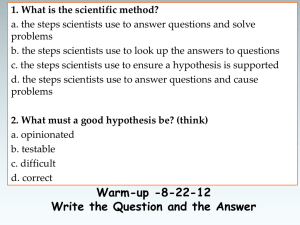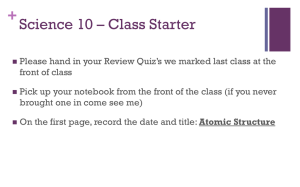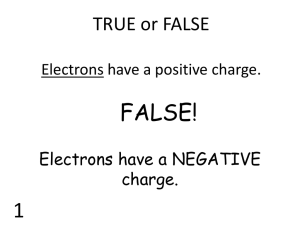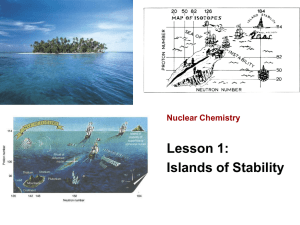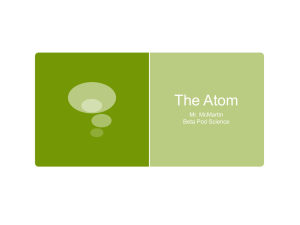Chapter 5 for Chemistry
advertisement
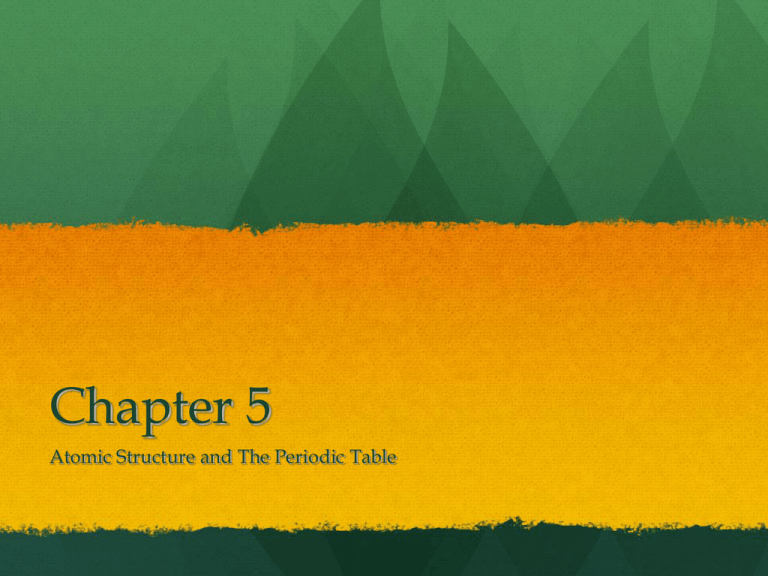
Chapter 5 Atomic Structure and The Periodic Table Just how small is an atom? http://imagecache5.art.com/p/LRG/6/667/USYC000Z/fedex-field--washington-d-c-.jpg Has anyone been to a professional football stadium or a major college football stadium? So then, most of the atom is just “empty space.” If the nucleus of an atom was the size of a marble, sitting at the 50 yard line, the electrons would be about the size of really little gnats (bugs) whizzing around the top rows of the upper deck. Angstoms (Å) 2,898,550,725 U atoms in 1m! http://intro.chem.okstate.edu/1314F00/Lecture/Chapter7/ATRADIID.DIR_PICT0003.gif Even the largest atoms are very small. The diameter of a uranium atom is only about 0.345 nanometers. A special unit is sometimes used to describe atomic dimensions, such as atomic radius or atomic diameter. Note the trend as you go across a row and down a column. That is the Angstrom. We use a Å to represent Angstroms (if you want to type that it’s shift-alt-A on a Mac and control-shift-2, shift-A on a bogus, inferior, Windows or Vista based machine). Angstoms (Å) http://upload.wikimedia.org/wikipedia/commons/1/11/Hydrogen_Atom.jpg Even the largest atoms are very small. The diameter of a uranium atom is only about 0.345 nanometers. 0.345 nm = 3.45Å 1nm = 10Å 1Å = 1 x 10-10 meters A hydrogen atom is the smallest atom. H has a diameter of only 0.74Å. About 13.5 billion hydrogen atoms could fit onto the edge of a meter stick. What does an atom look like? http://www.lanl.gov/orgs/pa/newsbulletin/images/Isotopes_logo.jpg In your notes, draw a simple picture of an atom. How about Lithium. What did you draw? AAA baseball club Albuquerque Isotopes logo (you need to know what isotopes are!) Atoms http://upload.wikimedia.org/wikipedia/commons/thumb/e/e1/Stylised_Lithium_Atom.svg/270pxStylised_Lithium_Atom.svg.png http://www.solarsystempictures.net/ Neutron Proton Electron Most people probably drew a nucleus of some type with electrons orbiting around it. Lithium Planets=Electrons Sun=Nucleus Possibly it looks a little like a mini solar system. Atoms are composed of Protons Neutrons Electrons Subatomic Particles Particle Relative charge Relative mass Actual Mass of (1 amu = mass of a Particle proton) Proton Neutron +1 1 amu 1.67 x 10-24g 0 1 amu 1.67 x 10-24g -1 0 amu 9.11 x 10-28g Electron Electrons Electrons were the first particle discovered. JJ Thompson discovered the electron and developed the Plum Pudding Model. The electron has a very small mass. It is actually 1/1840th the size of a proton (0.00054 times). In other words, if an electron was a smidge over a pound, protons and neutrons would weigh 1,840 POUNDS! Protons http://web.buddyproject.org/web017/web017/images/atom.JPG Protons were the next subatomic particle to be discovered. Protons were discovered by E. Goldstein. Protons have a relative mass of 1 and a charge of +1. Protons http://www.periodictable.com/Items/020.6/index.html Atomic Number Protons determine the “identity” of an atom. The number of protons is a property called “atomic number.” Atomic numbers are on the periodic table. The number of protons determines what kind of atom it is. H has 1 proton C has 6 protons U has 92 protons Protons Neutral atoms have the same number of protons and electrons. (Makes sense, right?) The charges balance each other out. (Ca has 20 protons, and must have 20 negatively-charged electrons to balance out those positive charges) Protons are located in the nucleus of the atom. (Where are the electrons?) Neutrons http://www.ct.infn.it/~rivel/Archivio/chadwick.jpg http://kwisp.files.wordpress.com/2009/05/adventures-jimmy-neutron-300-032707.jpg Neutrons are also located in the nucleus of the atom. Ooops, wrong neutron! Chadwick The nucleus was discovered by Ernest Rutherford, a former student of JJ Thompson. The neutron was the last particle discovered, by James Chadwick, a former student of Rutherford. Neutrons More than likely, the fact that neutrons had no charge made it harder to discover. The neutron has a relative mass of 1, the same as a proton. However, it has no charge. Therefore, we say that the charge = 0. The actual mass of a neutron is almost the same as that of a proton. It is slightly different P = 0.0000000000000000000000016726 g N = 0.0000000000000000000000016749 g Golf Balls In Beakers My Little Model of the Atom http://www.vias.org/physics/bk4_03_02.html These are in the lab somewhere. Find them. The pink balls represent protons. The white balls represent neutrons. Scientists quickly figured out by experimentation how many protons each element had. If you want to read more, check out the link above. Basically though…. The Nucleus http://www.chemicalelements.com/bohr/b0019.gif Since the neutrons are located in the nucleus, with the protons, substantially ALL of the mass of the atom is contained within the nucleus. Mass of nucleus in diagram 0.0000000000000000000000651 g Mass of electrons 0.0000000000000000000000000173 g What element is this?? In other words, if the nucleus weighed 651 pounds, the electrons (combined) would weigh less than a McD’s quarter-pounder patty. Why do the protons stick together in the nucleus? http://www.antonine-education.co.uk/Physics_AS/Module_1/Topic_5/strong_force.jpg The answer is strong nuclear force. It’s the strongest known force in the universe. It far, far stronger than gravity. It only can be felt when the particles are extremely close together, like when they are packed together in the nucleus. The secret’s in the attractions between the quarks… Protons and neutrons are made of quarks. It’s thought that the quarks attract other quarks and hold the nucleus together, even though all of the protons are positively charged and would otherwise repel each other. Objective E We already know that the number of protons is what makes an atom unique. Hydrogen has 1 proton. Carbon has 6 protons. Uranium has 92 protons. So, if “ProtonMan” The “atomic number” is the number of was a superhero, protons. We sometimes use a Z to he’d have a “Z” on represent atomic number. his suit?? Objective E So, for hydrogen, Z = 1 Don’t memorize these…they are on the Periodic Table For carbon, Z = 6 For uranium, Z = 92. What is the atomic number for Aluminum Zinc Chlorine Find THEM!! Objective F So, Z (atomic number) tells us how many protons an atom has. It does NOT tell you how many ELECTRONS you have (accurately) all the time! Most atoms have no charge. That means that the number of protons (which are positively charged) must balance out the number of electrons (which are negatively charged). Objective F Unless you are TOLD that the atom has a charge, you should assume it has no charge, and therefore, # of protons = # of electrons. Hydrogen (Z = 1) also has one electron. Lithium (Z = 3) also has 3 electrons. Carbon (Z = 6) also has 6 electrons. Uranium (Z =92) also has 92 electrons. BUT REMEMBER The numbers of protons doesn’t always equal the numbers of electrons. Objective F Some atoms can lose electrons. When they do so, they will form a positive “ion.” Some atoms can gain electrons. When they do so, they will form a negative “ion.” An ion is a atom which has an electrical charge (either positive or negative). We’ll get to those in Chapter 6. Na+1 and Cl-1 are formulas for ions. The number of protons cannot change. If the number of protons changes, it’s no longer the same element. Atoms can gain or lose electrons, but they can NOT gain or lose protons in any chemical reaction. Schwartz’s Law (a law I made up…hey, it’s my class) To calculate the number of electrons, use # of Electrons = Z – IC Where Z = atomic number and IC = ionic charge. Ex: Suppose we have a sodium ion with a + 1 charge. How many electrons does it have? Atomic number (Z) is 11 (find this on Periodic Table) and ionic charge is 1. # electrons = 11 - 1 = 10 Schwartz’s Law Let’s calculate a couple more… Ex: Suppose we have a sulfur ion with a - 2 charge. How many electrons does it have? Atomic number (Z) is 16 and ionic charge is -2. # electrons = 16 - (-2) = 16 + 2 = 18 Ex: Suppose we have an zinc atom with no charge. How many electrons does it have? Atomic number (Z) is 30 and ionic charge is 0. # electrons = 30 - 0 = 30 6 neutrons Objective F http://www.atomicarchive.com/Physics/Images/isotopes.jpg 8 neutrons How do we calculate how many neutrons we have? In order to do that, we need to look at another property, called atomic mass. The atomic mass of an atom = THE SUM of protons and neutrons. We will use another formula Hey these are isotopes again. Isotope = same # of protons but a different # of neutrons. # Neutrons = A – Z A = Mass Number So, what is Z again? Objective F http://www.lbl.gov/abc/Basic.html#Nuclearstructure Let’s look at an example. An atom of Bromine (Br-80) has Z = 35 and Mass Number = 80. How many neutrons does it have? (Br-80 doesn’t mean bromine with a charge of -80. When they write it like that, it’s a DASH and 80 is the mass number) # Neutrons = Mass Number - Atomic Number # Neutrons = 80 - 35 = 45 Objective G http://www.usagold.com/images/gold-coins-images.jpeg http://finestimaginary.com/shop/images/medium/jewellery/au_MED.jpg How do isotopes differ from each other? (You should know this by now). Look at gold (Au) on the periodic table. It says that the mass = 196.967. Since mass number and atomic number are ALWAYS whole numbers, how do we get .967? The answer is that the atomic masses on the periodic table are averages. Objective G They get that average atomic mass for Au by taking into account ALL of gold’s isotopes. Isotopes differ from each other in the number of neutrons. They behave the same CHEMICALLY because all isotopes of the same element have the same number of protons. The study guide talks about water and heavy water. Heavy water is the same as water, except that instead of H-1 it is formed using H-2, which is sometimes called deuterium. So while water has a molar mass of 18, deuterium oxide or heavy water has a mass of 20 (2 + 2 + 16) Math Alert Objective H How do we calculate the average atomic mass? To do so, you need to know 2 things: All possible isotopes for an element The percent abundance for each (in other words, how much of the whole is represented by each isotope). Objective H Let’s look at an example: Chlorine has 2 isotopes 35Cl which is 75.77% of the total amount of chlorine. 37Cl which is 24.23% of the total amount of chlorine. What is the average atomic mass of Chlorine? Objective H Cl-35 accounts for 75.77% of the total chlorine. CL-37 accounts for the rest. Remember to convert percents into decimals, you have to move the decimal point 2 places to the left. You then mutiply the percentage (in decimal form) times the mass number for that isotope. You do that for the other isotope too, and then add the answers together. Avg Atomic Mass = 35 (0.7577) + 37 (0.2423). Avg Atomic Mass = 26.52 + 8.97 = 35.49 Objective H In our class, we are always going to round average atomic masses to 1 decimal place. So, we’ll round 35.49 to 35.5 and that’s the average atomic mass of Chlorine that we’ll use. Why can’t you just average 35 and 37 (the two isotopes) and get 36 as the average atomic mass? Why is that wrong? The End



